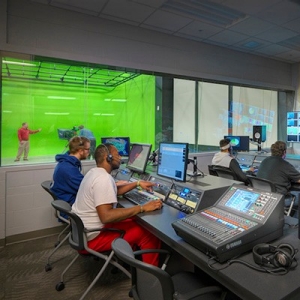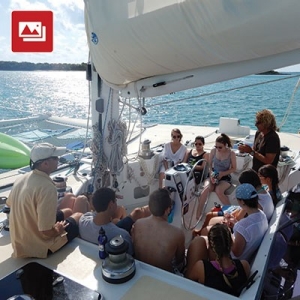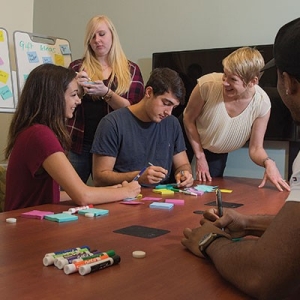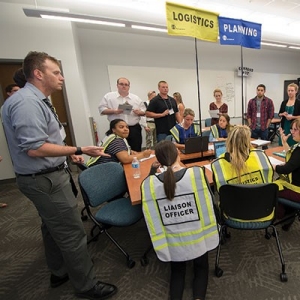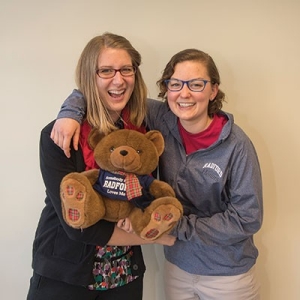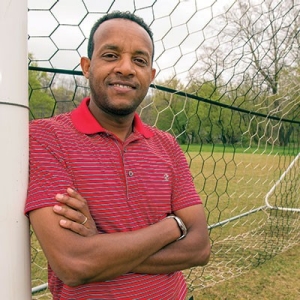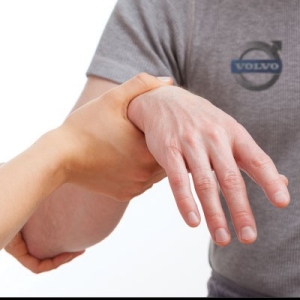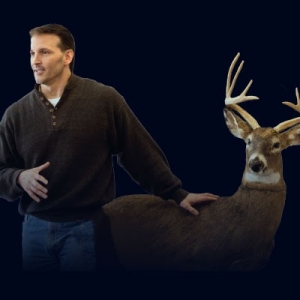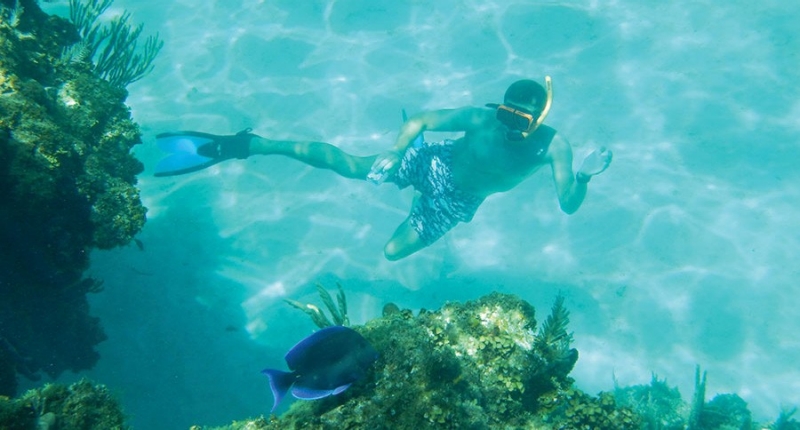The Experience
Student provides service for fellow veterans.
High-tech TV studio's cameras are rolling.
Tourism students sail on a 60-foot catamaran in the Sea of Abaco, Bahamas.
COBE opens Center for Innovation and Analytics.
New center prepares students to think through a crisis.
VanDerwerker duo ignites a spark on campus.
Radford University Associate Professor of Economics Seife Dendir has the answer.
Athletic training students receive experiences working with non-traditional athletes.
Criminal Justice Department deploys a decoy to shed light on wildlife crime.



Student provides service for fellow veterans
At Radford University, Juwell McClendon, M.S.W. ’17, found the passion that will direct her to a bright and meaningful future … for herself and her fellow American veterans.
McClendon, a 2017 Radford University Master of Social Work graduate, left Detroit at 18 looking for her way. After a stint in the U.S. Navy, she spent a year on the West Coast and returned to Norfolk, where she earned her undergraduate degree.
McClendon found Radford University and its School of Social Work as a result of a trip to a regional Rally in the Valley Social Work Summit. She liked the school’s strong reputation and the peaceful, rural campus. She enrolled, still puzzled about her direction.
At Radford University, McClendon identified a need — student veteran advocacy — to be addressed. She also found the atmosphere, education and opportunities she believes will prepare her to address it.
The Veterans of Foreign Wars-Student Veteran Association (VFW-SVA) recognized McClendon’s power to advocate for veterans. The organization named her to their 2017 class of VFW-SVA Legislative Fellows.
“When I left the military, I didn’t have a focus. My first try at college was unsuccessful because I didn’t have focus, a knowledge base or experienced mentors,” she said.
McClendon, who earned the Global War on Terrorism Expeditionary Medal during her four-year tour in the U.S. Navy, has prepared to fill the role she identified by its absence early in her career.
At Radford University, McClendon became the first graduate assistant assigned to the expanding Military Resource Center (MRC) and did a 600-hour, yearlong internship with the Veterans Administration at a community-based outpatient clinic (CBOC) in Wytheville.
Along with the opportunities she discovered at Radford University, she found mentors: Professor of Communication Bill Kennan, who directs the MRC; Assistant Professor of Social Work Philip Mongan, who directs Radford University’s longstanding internship program with the Salem Veterans Affairs Medical Center; and her research project supervisor, Assistant Professor of Social Work Mashooq Salehin.
McClendon said she thinks the helpful nature of which Radford University takes so much pride is part of her successful professional development as an advocate. She plans to incorporate that willingness to reach out in her future advocacy efforts on behalf veterans in the higher education environment.
“Any problem that came up, I found people to be very forthcoming with information, understanding and empathy to do what they could,” she said.
As she readies herself for the next stage of her career — a Ph.D. in social work or an aspect of higher education, a position at a university working with the expanding population of student veterans or in some as yet unimagined possibility — McClendon values her Radford University experience.
“It has been good,” she said. “Through the challenges and life lessons, I have grown personally and professionally. Radford provided many opportunities to engage my passion for advocacy and experiences that will guide and motivate me.”
McClendon’s contribution to the university she serendipitously discovered can be reflected in the growth of the MRC. According to Kennan, the MRC began humbly in 2012 at a table in the Learning and Resource Assistance Center. From Calhoun Hall, it now serves over 300 veterans, active duty personnel and military dependents.
“Juwell has been instrumental. She has a sophisticated level of understanding of policy, resources and what we ought to be doing,” said Kennan, who was named director of the MRC in 2016.
As McClendon’s internship supervisor, Mongan, added, “She is an advocate and a half. She brings a unique perspective that she shares tirelessly with her classmates and clients.”
Radford provided many opportunities to engage my passion for advocacy and experiences that will guide and motivate me."
In her time at Radford University, McClendon found a variety of ways to contribute. She was an advisor in the College of Humanities and Behavioral Sciences advising center before moving over to help organize the MRC. She has done a phenomenological research study on the lived experiences of student veterans within the higher education system and how they succeed with and without services and support. Last summer, she joined a handful of colleagues to do research in Uganda on parental and cultural perceptions toward childhood disabilities.
Prior to coming to Radford University, she worked as a social worker in foster care and adoption.
“That was hard, heartbreaking work and a different kind of advocacy,” she said. “I learned, though, that my niche is advocacy.”
As a VFW-SVA fellow, McClendon participated in a 10-person team research project that was presented during legislative visits on Capitol Hill and at the annual VFW National Legislative Conference in Washington, D.C., last winter.
“The VFW-SVA Fellowship was a great honor and gave me valuable advocacy experience at a new level,” said McClendon. “I spent the holiday break digging into policy, fact-finding and building my knowledge base. The fellowship made me realize that policy is very black and white, so facts, facts and more facts are needed. I redrafted my portion of the project five times before I felt it was good enough to submit.”
As a VFW-SVA fellow, McClendon advocated alongside VFW staff and represented Virginia on issues facing today’s student veterans. In conjunction with the VFW National Legislative Committee, McClendon met with policy-makers from federal agencies responsible for implementing veterans’ policy.
After the conference, McClendon implemented a local advocacy plan in her home congressional district, Virginia’s 9th, and reported to the Virginia VFW state convention, as well as local VFW and SVA national offices, about her experience.
McClendon embraces the unique opportunity to combine social work and personal experience at a high level.
“Being a veteran who worked hard toward my own education was an experience I lived, and I have good friends, too, who had trouble getting on their feet and reintegrating after discharge from the military,” she said. “I appreciate this and all the many chances I had to jump right into the deep water.”
The time spent working with her brothers and sisters-inarms at the Wytheville CBOC sealed the deal for McClendon.
“I did a little bit of everything,” McClendon said. “I learned something new daily from the veterans and their families about their needs — and their spirit. The camaraderie is amazing.”


| We're on in 3...2...1 High-tech TV studio's cameras are rolling. |
| Tourism Students Set Sail Tourism students sail in the Sea of Abaco, Bahamas. |
| Challenge, Cultivate, Connect COBE opens Center for Innovation and Analytics. |
| The Artis Legacy Historic announcement of the Artis Endowed Scholarship Fund. |
| The Strategy Space New center prepares students for a crisis. |
| Sister, Sister VanDerwerker duo ignites a spark on campus. |


Radford University students familiarize themselves with the technology of the CHBS TV studio
The lights are shining and the cameras rolling inside the College of Humanities and Behavioral Sciences (CHBS) television studio, which opened its doors to Radford University students, faculty and staff in January.
The TV studio is a learning space inside the CHBS building and will allow students to gain advanced broadcast experience in a professional setting.
“Students are able to get in and get hands-on experience in a news studio,” said the college’s technology specialist, Jeremy Jennings. “The studio is set up so students are able to get dedicated experience at different positions. Students will know the function of each piece in the studio.”
The embedded nature of each position within the studio allows for an immersive educational experience.
“Students have a remarkable opportunity to immerse themselves in all aspects of production, at length and over time,” said School of Communication Director Matthew Smith. “This is more meaningful than a mere tour of an operational facility; students operate a facility themselves, figuring out how the technology works and having the chance to experiment with its capabilities, while pushing their own.”
The TV studio is full of advanced technology that meets or exceeds that of local newsrooms.
“It is on the higher end of studios,” Jennings said. “Around the area, we are comparable if not better than other studios.”
The studio incorporates a piece of that new technology — a robotic camera, which is controlled from the production room.
“If a professor needs to do an interview on a television network, you can do the interview with minimal staff,” Jennings said. “The camera can be completely controlled from inside the production room. The robotic camera has the same lens as the other studio cameras, so there is no difference in the image quality. Otherwise, the camera is a secondary camera during productions.”
Jennings said that the robotic camera functions are easy to control, “especially if you have played a video game before.”
The original concrete floor caused audio and video issues during filming, which led to Jennings and the School of Communication installing advanced flooring in the studio.
“It was just cement at first, but it caused some jitteriness when rolling the cameras around,” Jennings said. “We can roll the cameras freely and output a smooth, consistent image. The floor is a no-noise material, so movements don’t impact the audio.”
A common tool inside of the production studio is a green screen. The screen is composed of a material that allows the background to be changed. A uniform color, and in the case of the CHBS TV studio, a bright green color, coats the wall.
Having a professional learning space gives our students the opportunity to work in an environment that mirrors what they will be working in once they leave Radford University."
The screen inside of the studio goes to the floor, with a gradual curve at the base, allowing for consistent lighting over the entirety of the screen to enable proper image replacement.
“The green screen floor,” Jennings said, “allows us to stand on the green screen and get a full-body shot.”
The combined technological power of the learning space gives students professional opportunities during their collegiate career and aids them after graduation.
“Having a professional learning space gives our students the opportunity to work in an environment that mirrors what they will be working in once they leave Radford University,” said Assistant Professor West Bowers. “This better prepares students for that first job and for what they will encounter in their professional lives.”
The initial use of the studio will lean toward instructional purposes so that students and staff members alike will have time to be properly trained in the use of the new technology. The studio will also be used for Radford Athletics video promotions.
As for the studio’s long-term future, a closed-circuit cable network is in development.
“We want to give students experience running live news shows,” Jennings said. “It gives students an opportunity to get positive feedback on running a live news show and gives students tangible experience. We will have a place where students, faculty and staff can get real campus news.”
The launch of the closed-circuit campus news channel is expected within two years.


| At What Age do Soccer Players Peak? The Department of Economics has the answer. |
| Tourism Students Set Sail Tourism students sail in the Sea of Abaco, Bahamas. |
| Challenge, Cultivate, Connect COBE opens Center for Innovation and Analytics. |
| The Artis Legacy Historic announcement of the Artis Endowed Scholarship Fund. |
| The Strategy Space New center prepares students for a crisis. |
| Sister, Sister VanDerwerker duo ignites a spark on campus. |

Each maymester, Assistant Professor of Recreation, Parks and Tourism Josh Carroll and a small group of students make their way to the Bahamas — where if the wind is right you can sail away and find tranquility — for a week to learn about coral reef management, beach use and island tourism, as well as marine and charter boat tourism trends.
“The boat becomes our living, learning classroom,” Carroll said.
Out at sea, the group visits both populated and remote islands to examine local fish, reefs, beaches, historical attractions and “their interrelationships with local livelihoods,” said Carroll, who has been leading the excursion since he joined the recreation, parks and tourism faculty in 2013.
The course is designed to provide invaluable information and experience in marine-based tourism. Topics covered in the class are numerous and include tourism management, sustainable tourism and service industry response to demand.
“I want my students to realize how big and important tourism is for the economic development of the communities in the Bahamas,” Carroll said. “It’s extremely important to the people there. They need it for survival."
“It may sound strange” Carroll continued, “but we face similar challenges in southwest Virginia, where tourism has begun to replace more extractive economies and becomes a pathway to sustainable community development. Our students having skills in these areas is very valuable in today’s job market.”
Carroll’s course has three levels. First, there is the classroom prep work before anyone steps foot onto the sailboat. It’s no day at the beach.
“We have long days, and it’s a lot of work,” Carroll said. “Before departure, we spend a week on campus laying down the conceptual framework for research projects the students will conduct in the Bahamas, and cover a lot of lecture material. It’s a lot of information jammed in before going to the Bahamas.”
The prep work includes spending a day on a small sailboat at nearby Claytor Lake.
“There, I do an introduction to sailing concepts and safety,” Carroll said. “It’s mostly information so they can be safe when they get on the big boat. That way, things are not completely foreign to them.”
Soon thereafter, Carroll and his students are sailing on the beautiful majestic blue waters, basking in the warm ocean breezes and taking in the enchanting island views. They anchor in harbors and off small, sandy cays such as Treasure Cay, Guana Cay, Hopetown, Little Harbour and Man-o-War Cay.
“A week on a boat with 13 students your age sounds perfect, right?” asked Megan Valentine ’16, who was part of the May 2016 course. “It is until everyone is hanging off the back of the boat, seasick.”
This trip helps [the students] shape a piece of their worldview to gain a better understanding of different cultures, views, economic structures, problems, opportunities and issues.
It takes some time to adjust, said Carroll, explaining the various difficulties of life on a vessel.
“We go there to work, and working on the boat can be challenging,” Carroll said. “On board, days go from 6 a.m. to about 9 or 10 p.m. and are jam-packed with lectures, group data collection, snorkeling, local tourism operation visits and many guest speakers on a wide range of topics. We also carry all our own water and handle all our own garbage and waste. It’s an interesting lesson in living closely together and living consciously.”
Carroll and his companions spend three days engaging with people involved with nonprofit organizations and local tourism groups, such as the Bahamas Ministry of Tourism.
Part of the learning experience involves each student adopting a tourism-based business. This means identifying and researching a business. While on the island, each student meets with a representative from their chosen business.
“They interview them and ask about longevity of the business, the history, what’s successful and what’s not and about plans for expansion,” Carroll explained. “They learn the ins and outs of running the business.”
No trip to the Bahamas would be complete without snorkeling, beach excursions, island resort tours, arts and music and so forth. There is plenty of time for those things. Between the fun, however, there is more work to do.
Carroll and his students conduct an inventory, called the Tourism Opportunity Spectrum, of six different attributes that relate to tourism opportunities in an area. The sites have been identified by the Bahamas National Trust — “it’s like our National Parks Service,” Carroll said — and the information gathered has led to two peer-reviewed publications for Carroll and students, who serve as co-authors.
They’ve also presented the research at the Resort and Commercial Recreation Association Conference each November for the past two years.
“One of the great things about the conference is it offers a full day and a half for employers to interview students for upcoming jobs and internships,” Carroll said. “Last year (2016), every one of the 12 who went to the conference got a job offer or internship offer. Some got multiple offers. It’s really good for them to attend and present. And doing the work in the Bahamas helps further their chances for internships and employment.”
Once they have returned from the island, there still is work to do back in Radford.
For the businesses each student adopted, they must get to work on creating a promotional packet. This includes a video, a social media piece and a brochure. The students share the work with their respective business, and some of those businesses use the packets.
“It’s a great learning experience for the students, and it keeps them connected with some of the businesses in the Bahamas,” Carroll said.
To complete the nine-credit-hour course, the students must demonstrate what they’ve learned by conducting their own tours for Carroll and their classmates around the New River Valley. It can be any place in the region they choose. In addition to planning, designing, and guiding the actual tour, they must prepare the itinerary, “which tells us what we need to have a successful day,” Carroll said.
The “big picture,” for offering the course, Carroll said, is for the students to understand a larger world view.
“Some of the students who go on the trips have never left the country or been on an airplane. This is a big eye-opener,” he said. “This trip helps them shape a piece of their worldview to gain a better understanding of different cultures, views, economic structures, problems, opportunities and issues.”
Sailing away with the Tourism Institute is something Caitlin Coleman will remember for the rest of her life, she said.
“Making the decision to be a part of this program through Radford University was one of the best I’ve made,” said Coleman, who was on the 2016 trip. “Fifteen of us lived, ate, showered and slept on a sailboat together, and we all ended up becoming pretty close even though it was only for a couple of weeks. I’m so grateful I had the opportunity to experience Bahamian culture in a way that you wouldn’t see on a vacation.”


| At What Age do Soccer Players Peak? The Department of Economics has the answer. |
| Caring for the Industrial Athlete Althetic training students work with non-traditional athletes. |
| Challenge, Cultivate, Connect COBE opens Center for Innovation and Analytics. |
| The Artis Legacy Historic announcement of the Artis Endowed Scholarship Fund. |
| The Strategy Space New center prepares students for a crisis. |
| Sister, Sister VanDerwerker duo ignites a spark on campus. |


COBE opens Center for Innovation and Analytics
The College of Business and Economics (COBE) is combining innovation and analytics in a new center designed to challenge minds, cultivate talents and connect students and faculty in a technology-rich learning environment.
COBE’s Center for Innovation and Analytics opened its doors with the beginning of the 2016 fall semester with the purpose of developing a strong focus on student learning and faculty involvement in solving real-life business problems in active collaboration with industry partners.
A goal for the center is to become a destination of choice for students, entrepreneurs, intrapreneurs, alumni, community partners, faculty and staff interested in innovation and analytics.
“The goal for the center is going to be the champion for innovation and analytics for the college and beyond,” COBE Dean George Low said.
A priority for the center is to focus on innovation and analytics through ways that synergistically enhance the educational experience Radford University students receive in the college.
“The opportunity the center presents is to bring innovation and analytics together in a way that is unique, that focuses on critical thinking and that helps our students understand that they have to be good at both to be successful in business today,” Low said.
Two COBE faculty members are serving as co-directors of the center. Management Professor Steve Childers is leading the innovation side, while Marketing Professor Wil Stanton guides analytics.
“These two faculty members have distinguished records in the fields of innovation and analytics,” Low said. “In their roles, they are in a position to apply their expertise and passion for these two pillars of our strategic plan to the growth and development of this new academic center.”
The center connects theory with practice, Stanton said, by offering an active learning environment including applied projects and hands-on experiences, such as the COBE/BB&T Innovation Competition that began in 2015 and drew more student participants in 2016.
“I hope business leaders, community supporters and alumni will join us in our programs by contributing as advisors, serving as mentors and connecting with our students through internships, externships, case-based learning and guest lecturing,” Stanton said.
Located in Kyle Hall, the center is not exclusive to COBE; it is open to the entire campus community.
“We invite faculty and students from all disciplines across campus to attend and participate in the center’s programs,” Stanton said. “The center will help students to be better prepared to meet the expectations of employers.”
The center provides students with short courses, workshops, seminars, active learning activities, hands-on training and certification in Microsoft Office products, Bloomberg, Excel, SQL, SAS including Base SAS and Enterprise Miner, SPSS including SPSS Statistics, Modeler and CoreMetrics, Web/Google Analytics, Access, R and Cognos.
“We want students to know that employers look for creativity and innovativeness in new employees. They also look for critical thinking and analytical reasoning,” Stanton said. “Some employers want Excel certification, but the certification alone says ‘I was dedicated, persistent and I learned this.’ The analytical process of getting certification is what a lot of companies look for to solve big problems.”
Overall, Stanton said, the Center for Innovation and Analytics “represents the nexus of innovation and analytics, as analytics is driving innovation and innovation is driving analytics — they overlap — and together they are transforming industries worldwide.”
Childers said the center will have accomplished its mission “when innovation and analytics are intertwined throughout everything we do toward the mission of Radford University. That will be when it becomes a necessary element of anything we do.”

“I feel like nursing is a quiet science. Nursing is not one of those things people think of when you say ‘science.’ They think of biology, chemistry, physics and disciplines like that. Nursing is a science with an added focus on the holistic, or the entirety of the human experience,” said Linville, the daughter of Raymond Linville, former dean of the Waldron College of Health and Human Services, chair of the communication sciences and disorders department, and a founding faculty member of the Doctor of Physical Therapy program.
Kaur considers her two years as a biological researcher a key investment in career success as a health care provider.
“We mostly got into it to strengthen our scientific research base,” said Kaur. “I wanted to look into research protocols and to analyze and apply them to what I am doing,” Kaur said. “I wanted to get comfortable with evidence-based practice. These are opportunities peripheral to daily nursing work that I know will be valuable.”
Kaur, a double major in nursing and Spanish, also considered the research opportunity a way to engage her curiosity and diverse interests.
“I just wanted to do what I found interesting. I like biology, I like Spanish and my goal is to be a nurse,” she said. “I like pushing myself to see what I can do and what I can achieve. Radford was a place to do them all.”
Kaur and Linville wrapped up the nursing student stages of their careers with practicums that entail 168 hours of 12-hour-a-day shifts at Roanoke Memorial Hospital — Kaur on the progressive care unit and Linville on the med/surg unit.
Both will also complete independent study projects — Kaur in Spanish, Linville in biology — to wind up their undergraduate careers at Radford.


| At What Age do Soccer Players Peak? The Department of Economics has the answer. |
| Caring for the Industrial Athlete Althetic training students work with non-traditional athletes. |
| Deer in the Headlights Criminal Justice deploys a decoy. |
| The Artis Legacy Historic announcement of the Artis Endowed Scholarship Fund. |
| The Strategy Space New center prepares students for a crisis. |
| Sister, Sister VanDerwerker duo ignites a spark on campus. |


New center prepares students to think through a crisis
When running a crisis simulation, students used a room in the basement of Heth Hall, equipped with a single projector. Now, students are using two of the most technologically capable rooms on campus.
The third floor of the College of Humanities and Behavioral Sciences (CHBS) building on the campus of Radford University houses two unique learning spaces — the Emergency Operations Center (EOC) and the Social Media Watch Center.
A primary function of an EOC is to have key decision-makers come together — in a technologically capable space — and figure out how to resolve a crisis. The focus inside of an EOC is on strategy rather than on tactical details in how to specifically resolve a crisis.
These are skills that Criminal Justice Department Chair Stephen Owen teaches students in his emergency preparedness courses. Owen’s courses utilize both new learning spaces on campus through crisis simulations, typically held at the end of each semester.
“These are flexible spaces that bring together key decision makers to help provide both assistance and coordination for an ongoing incident,” Owen said. “Each scenario has different needs which an EOC helps to support.”
Part of the robustness needed for a successful operation lies within efficient — yet effective —communication between the EOC and the social media watch center.
“As persons in the watch center review incoming data, they can alert the incident commander to important information, and the EOC can pull the same data on its screens,” Owen said.
A temptation that comes with having access to a multitude of raw information is to pass along everything to the incident commander. During a crisis, it is important for the people inside of the watch center to serve as an information filter for the incident commander.
“The incident commander only needs to know what they need to know to do their job,” Owen said. “Someone needs to filter that. Raw data should be coming into the watch center, which can then be in communication with the EOC to build situational awareness.”
Some of the information that is posted to the video boards will pertain to computeraided dispatch feed, pending calls, photos from the scene, a map of the incident area and incident objectives.
Owen and his classes use the EOC to conduct professional emergency preparedness exercises. Each scenario differs and takes students through an emergency in a safe environment.
“The simulations allow students to apply emergency management concepts. Mistakes can be corrected now as students get comfortable with the relevant frameworks, so when they are at an actual scene, they can make better decisions and judgments when it really matters,” Owen said.
We wanted to give students the ability to work in a professional environment that will mirror what they will see out in the field."
The EOC is an enormous step forward as an educational space at Radford University.
“We looked at actual EOCs when in the design phase,” Owen said. “We wanted to give students the ability to work in a professional environment that will mirror what they will see out in the field.”
All fields and careers will deal with emergencies — either directly or indirectly — while on the job.
“I think this helps for them to know what is going on behind the scenes at the command post,” Owen said. “When they are in a scenario, even if they are not a commander or on the command team, they will have a context for why things are happening and how they fit into the incident command structure. It is a very real professional skill.”
Loaded with NUVI software, the Social Media Watch Center can analyze various social media platforms to search for trends, opinion leaders and origins of posts. The software can sort the data by emotion or sentiment. Each region is highlighted in either green, red or blue as a quick-reference for the sentiment behind each post.
School of Communication Assistant Professor John Brummette, who works with Owen on crisis simulations, applies the software to analyze trends, all in real-time. Having the analytical power of the NUVI software allows students to understand and harness the data to spot potential branding issues or respond to a crisis.
Criminal Justice and the School of Communication capped off the first year in the new CHBS building with a three-hour crisis simulation.
“Students work with the theories, concepts and technologies that guide professional practice. Being able to do so in a facility that parallels those in the workplace allows them to better be prepared for their chosen careers,” said Owen.


| At What Age do Soccer Players Peak? The Department of Economics has the answer. |
| Caring for the Industrial Athlete Althetic training students work with non-traditional athletes. |
| Deer in the Headlights Criminal Justice deploys a decoy. |
| The Artis Legacy Historic announcement of the Artis Endowed Scholarship Fund. |
| An Advocate and a Half Student provides services for fellow veterans. |
| Sister, Sister VanDerwerker duo ignites a spark on campus. |


VanDerwerker duo ignites a spark on campus
As happens annually at graduation, talented and motivated students head out to the “real world.”
In May, when Kenzie and Audra VanDerwerker graduated, the campus lost a couple of superstars.
The sisters from Bedford — Kenzie, who got her bachelor’s degree in communication sciences and disorders in 2015 and her master’s in 2017, and Audra, who graduated with a B.S. in psychology in 2017 — set unique and high levels for achievement — and multitasking — while at Radford University.
In November, Kenzie was named National Student Speech-Language-Hearing Association (NSSHLA) student state officer, representing Virginia’s students as part of the organization’s leadership councils. She has also presented research on the university, state and national level. At the ASHA (American Speech-Language-Hearing Association) national convention, the second-year graduate student made a solo poster presentation, titled “Attention Deficit Hyperactivity Disorder: Enhancing the understanding of ADHD on executive functioning in school-age students.” Early in her time at Radford University, Kenzie worked as a resident assistant and most recently served as president of the University’s chapter of the NSSHLA.
Audra, who minored in exercise, sport and health education, also presented research at the university and regional levels and tutored at the Learning Assistance and Resource Center.
In their “spare” time, the sisters teamed up to win two world championships at the Odyssey of the Mind (OOTM) competition. The sisters also embraced the organization’s service ethic and served as Odyssey Angels. They annually prepare Halloween costumes for children with disabilities from the Bedford and Lynchburg areas.
Not just cute mask and glitter costumes, either. But mechanical structures that enable children in wheelchairs to trick-or-treat in style with their ambulatory classmates.
“The kids get noticed for the costumes, not their wheelchairs,” said Audra, who estimated that the sisters spend 100 hours each Halloween to design, build, paint and deliver the distinctively decorated costumes made of PVC pipe, cardboard and whatever else can be scrounged.
“Our apartment here spills over with the production, and as we get closer to delivery, our parents’ front room looks like a workshop.”
I found a place where I could do so many things - research, volunteer, service and work."
Both VanDerwerker sisters competed successfully in the Southern and Northern Atlantic Forensic Union (SNAFU). Both continued their interest in history that began in high school with the annual National History Day competitions.
Audra annually produces a new video exploring aspects of the Holocaust. At the 2016 SNAFU championships, the aspiring Doctor of Physical Therapy (DPT) candidate’s seriocomic forensic presentation about chronic traumatic encephalopathy and strategies to protect children from sports-related head injuries earned her fifth- and sixth-place finishes.
“I think staying busy makes everything easier. You just flow along from one interesting thing to another,” said Audra of her formula to fill a 24- hour day with 36 hours of activity.
Kenzie, who completed her fulltime practicum to check off one more requirement of professional licensure as a speech-language pathologist, called it a mindset, and one that has flourished at Radford University.
“I found a place where I could do so many things — research, volunteer, service and work. Radford gave me an open field in which to develop my leadership skills and gain confidence … one thing led to another,” said Kenzie.
A gateway for the VanDerwerkers to their high-achieving Radford University experience was the Honors Academy. Both sisters are proud alumni of the academy that defines itself by intellectual curiosity and active engagement in the educational process.
“They do things just because they are passionate about learning,” said Honors Academy Director Niels Christensen. “Each is different and has her own vibe. Together, though, sister they are a whirlwind — energetic, enthusiastic and curious.”
I think staying busy makes everything easier. You just flow along from one interesting thing to another."
Kenzie came to Radford University in 2011 and Audra joined her in 2014. Both entered as juniors, as they had earned enough credits from an early college program at Liberty High School that enables motivated students to supplement their high school curriculum with community college credits.
Curiosity steered Kenzie to inquire about continuing her History Day interest at Radford University. Christensen put her in touch with Office of Undergraduate Research and Scholarship Director Joe Wirgau.
At the 2011 Undergraduate Research Forum, VanDerwerker produced and performed a 10-minute living history presentation on the 1911 Triangle Shirtwaist Factory fire, a deadly industrial fire in New York that killed 146 garment workers, mostly women. Kenzie has since focused on research in her field, doing a pilot study on therapy approaches to selective mutism and studying double-meaning work jokes in autism.
Audra has racked up her own field-specific research portfolio. Her honors capstone project is about corticotropin releasing hormones in the hypothalamuses of rats.
“For me, it comes down to the professors and their impact. That is what has made my Radford experience so memorable,” said Audra. “They go far beyond the classroom to meet and continue teaching. Whatever my future holds, I will always consider them invaluable to my successes.”
Kenzie has seen Radford University from both the undergraduate and graduate perspectives.
“Radford prepared me for the workload as an undergraduate and then taught me as a graduate student what I need to know as a professional,” she said. “The other experiences have really helped me become comfortable leading and managing multiple tasks and passions.”
As sisters, the pair shares a bond. After rooming together and collaborating as OOTM teammates, they say they still like each other.
“I had a bumpy first semester when I first came to Radford,” said Audra. “I saw how engaged Kenzie was, and that encouraged me to get involved and do my thing.”


| At What Age do Soccer Players Peak? The Department of Economics has the answer. |
| Caring for the Industrial Athlete Althetic training students work with non-traditional athletes. |
| Deer in the Headlights Criminal Justice deploys a decoy. |
| The Artis Legacy Historic announcement of the Artis Endowed Scholarship Fund. |
| An Advocate and a Half Student provides services for fellow veterans. |
| We're on in 3...2...1 High-tech studio's cameras are rolling. |


Harry Kane is a dynamic, unstoppable striker for Tottenham Hotsupt.
He scores fantastic, breathtaking goals, seemingly at will, against some of the world’s best soccer teams in the English Premier League.
Kane, who is 24 years old and already a superstar, hasn’t yet hit his peak age, according to research conducted by Radford University Associate Professor of Economics Seife Dendir.
For years, soccer managers and executives have speculated about the peak age for professional soccer players. All previous evidence has been anecdotal and subjective, with no formal analytics being applied to the questions.
Using statistics from WhoScored.com, Dendir conducted a study using data from fall 2010 to spring 2015 from four major European soccer leagues, including the Premier League, to formally analyze the peak or optimal age of a professional soccer player.
He wrote about his findings in a paper, “When do soccer players peak? A note,” in the Journal of Sports Analytics, which was published in 2016.
Dendir’s findings suggest that on average, professional soccer players peak between the ages of 25 and 27, depending on their positions on the pitch. Goalkeepers were not included in the study.
“In the preferred models, the average forward peaks at 25, whereas the typical defender peaks at 27,” Dendir wrote. “For midfielders, the estimated peak age varies by model, but still occurs in the 25–27 age band.”
Defenders, Dendir explained, “experience relatively minimal curvature in the age-performance relationship. Further results show that peak age may vary directly with ability.”
Dendir’s findings could impact the economic decisions team executives make when putting together their team rosters. “They have to ask, ‘Are we paying too much or too little?’ This study can give them an idea of whether or not they want to pay a premium price for particular players.”
One discussion Dendir hopes his study will generate pertains to the American soccer model versus the European model. In Europe, players tend to turn professional at an earlier age than do American players, thereby gaining more experience in professional leagues during their peak years.
“Is it too late a start for American soccer players, who are going to be competing with other professionals?” Dendir said. “By the time American players become professionals, they are already four or five years behind their European peers.”
Dendir’s areas of research traditionally include economic development, applied microeconomics and econometrics. However, his love for soccer influenced him to delve into the data and take a closer look at a question that thus far had been answered with only anecdotal and subjective evidence from the game’s players, coaches and executives.
His study provides the first systematic, comprehensive and thorough investigation of the issue.


| Tourism Students Set Sail Tourism students sail in the Sea of Abaco, Bahamas. |
| Caring for the Industrial Athlete Althetic training students work with non-traditional athletes. |
| Deer in the Headlights Criminal Justice deploys a decoy. |
| The Artis Legacy Historic announcement of the Artis Endowed Scholarship Fund. |
| An Advocate and a Half Student provides services for fellow veterans. |
| We're on in 3...2...1 High-tech studio's cameras are rolling. |

At Volvo, our students get to have interactions with what some people call the industrial athlete, or the nontraditional patient. Athletic trainers are getting more and more into settings like Volvo."
As the assembly line rumbled just a few feet away, Kelly Hartman listened to a plant worker explain an issue with his leg.
“He was touching his leg, and he told me what he did to it and what he did on the assembly line,” Hartman said of the man describing his injury. “I asked him some questions and then provided some possible options for follow-up care.”
Hartman and fellow athletic training major Megan Dee talked with many people that day at the Volvo New River Valley plant health and wellness fair. They listened to plant workers and informed them of simple stretches and exercises they could do to possibly ease the aches and pains they earned through repetitive motions during a hard day’s work.
Hartman and Dee, both seniors and members of the University’s Athletic Training Student Association, attended the health fair armed with cards, flyers and a wealth of knowledge to help explain workplace ergonomics, stretching and injury prevention. Injuries such as carpal tunnel, plantar fasciitis and shoulder and back pain are common on an assembly line, Dee said.
At the fair, “someone might walk up and tell us, ‘My shoulder hurts.’ Then we ask, ‘What do you do at work?’ or ‘Do you do this repetitive motion?’” explained Health and Human Performance Assistant Professor Ellen Payne as she rotated her wrist. “‘If you do, try doing this stretch.’ We tell them a lot of preventative things they can do.”
If it seems to be a minor injury, “We tell them to get it looked at by a doctor,” Payne said. “They need to take care of it early and not let it develop into something that’s going to end up as a workmen’s comp claim and time off.”
Payne first organized the trip to the Volvo health fair two years ago as a way to immerse athletic training students in experiences working with individuals who are not traditional athletes.
“At Volvo, our students get to have interactions with what some people call the industrial athlete, or the nontraditional patient,” Payne said. “Athletic trainers are getting more and more into settings like Volvo.”
For Radford University athletic training students, it’s their initial experience working with employees at an assembly plant setting.
“They’re in the factory, they can see the machines employees work with every day. For their clinicals here at Radford, they’re usually at high schools, colleges and physical therapy clinics. That’s more of the traditional athletic training route, but as the profession grows and as new jobs are created, we’re seeing more and more athletic trainers in industry.”
The change in setting and type of patient was important to Hartman, who plans to pursue a career in athletic training, perhaps in the military or industrial setting such as Volvo.
“It was really cool getting the experience in industry,” Hartman said. “It’s a change from working in an athletic setting. It’s great getting that experience.”
Companies around the world are recognizing the value of having athletic trainers work with their employees. Having healthy workers can save a company money through injury prevention, Payne noted.
Kevin Muniz ’05 coordinates wellness and fitness programming at Volvo. It was his idea three years ago to bring Radford University athletic training students into the plant for the fair.
“I wanted to bring the athletic trainer students in because we have a lot of ankle, knee, hip, back, shoulder, elbow, wrist and finger issues and overuse injuries here,” Muniz said. “Like athletes, these employees need to get back to their playing status as soon as possible.”
Plant workers can’t “take time off from their work like an athlete can from their sport,” Payne said. “They have to keep working.”


| Tourism Students Set Sail Tourism students sail in the Sea of Abaco, Bahamas. |
| Challenge, Cultivate, Connect COBE opens Center for Innovations and Analytics. |
| Deer in the Headlights Criminal Justice deploys a decoy. |
| The Artis Legacy Historic announcement of the Artis Endowed Scholarship Fund. |
| An Advocate and a Half Student provides services for fellow veterans. |
| We're on in 3...2...1 High-tech studio's cameras are rolling. |


Egan Green (center) and senior Carly Ruth (right) practice movements with Buddy the Buck, the deer decoy (left).
Criminal Justice Department delploys a decoy to shed light on wildlife crime
Imagine you’re a current student in the College of Humanities and Behavioral Sciences and you’re walking through the halls of its new building, rushing to get to the elevator so you can make it to class. You push the call button.
The elevator arrives and the door slowly opens. A pair of eyes stares back at you — but they aren’t human.
As your brain rushes to figure out what your eyes are seeing, students push the deer out of the elevator on a cart, with one holding a remote controller.
What you and other students just saw was a mechanical decoy deer, a tool used to teach students in wildlife crime how to effectively combat spotlighting, a term used to describe a type of illegal hunting.
During such an operation, officers place the deer offroad, hidden enough to make the deer appear realistic but also visible to a passerby. Officers typically hide on either side of the decoy and the entire operation is recorded.
“Having a realistic wildlife decoy at Radford University is a great tool to give students hands-on experience,” said Criminal Justice Professor Egan Green. “I’m not aware of anywhere else that teaches a class on wildlife crime and conservation enforcement. There’s no book. It’s a niche class that we offer.
“I give students practice using the tools of the trade. It takes practice to make movements smooth and lifelike. When students apply to agencies, they are able to say that they have experience using a decoy.”

When seniors Carly Ruth and Grant Scott first saw the deer, they thought it was mounted.
“I saw that the front leg was detached, which isn’t a normal thing for a full-mounted deer,” Scott said. “I knew something was up, but I had no idea what it was until the head started moving slightly.”
Ruth said that she could see Green looking down each time the deer moved, so she knew that he was controlling it.
Both students agreed that the deer decoy aided their understanding of spotlighting while doing so in an interesting and unique way.
“This was the perfect class for me,” Grant said. “This is something I’m really interested in and something for which I have a passion. When applying to jobs, which will mostly be in rural counties, I can tell the departments that I’m familiar with some of the ways they catch poachers.”
“It helps that the deer decoy is different,” Ruth said. “It gives you an edge if you’ve never heard about it before or had the opportunity to use a decoy before.”
Another objective for students in Green’s classes highlights the shared resources between departments and offices.
“It helps because there is a lot of overlap between agencies, since a lot of them need help from others,” Ruth said. “Some agencies are subject-specific, such as wildlife. If there was ever an issue where one agency needed to have additional skills, they can easily shift between agencies for help.”
Ruth summed up the opportunity of Radford University’s Criminal Justice Department when she said, “Not many universities have someone who specializes in this field. These classes open your eyes to all the possibilities within criminal justice.”


| Tourism Students Set Sail Tourism students sail in the Sea of Abaco, Bahamas. |
| Challenge, Cultivate, Connect COBE opens Center for Innovations and Analytics. |
| The Strategy Space New center prepares students for a crisis. |
| The Artis Legacy Historic announcement of the Artis Endowed Scholarship Fund. |
| An Advocate and a Half Student provides services for fellow veterans. |
| We're on in 3...2...1 High-tech studio's cameras are rolling. |


